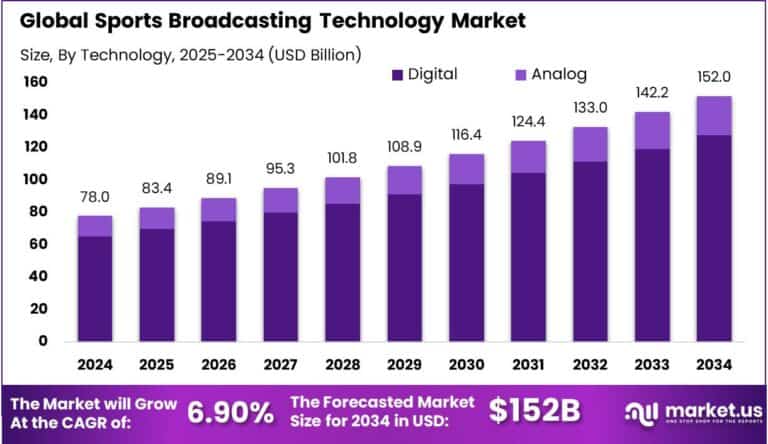Table of Contents
Introduction
The global sports broadcasting technology market is expected to grow from USD 77.98 billion in 2024 to USD 152 billion by 2034, at a CAGR of 6.9%. In 2024, North America dominated with over 34% market share, generating approximately USD 26.5 billion in revenue. The U.S. segment accounted for USD 25.1 billion, growing steadily at a CAGR of 4.3%. This growth is driven by increasing demand for high-quality live sports coverage, technological advancements like 4K streaming, augmented reality, and growing investments in digital and OTT platforms.

How Tariffs Are Impacting the Economy
Tariffs on broadcasting equipment, such as cameras, servers, and networking hardware, raise production costs and prices for service providers. These increased costs often transfer to broadcasters and consumers, potentially reducing demand and slowing revenue growth. Supply chain disruptions force companies to seek alternative suppliers or shift manufacturing, incurring additional expenses and delays.
➤ Discover how our research uncovers business opportunities @ https://market.us/report/sports-broadcasting-technology-market/free-sample/
(Use corporate mail ID for quicker response)
Retaliatory tariffs intensify trade tensions, creating uncertainty that hampers investment and innovation in broadcasting technologies. The cumulative effect slows digital transformation and infrastructure upgrades, impacting economic activity in media and entertainment sectors. Tariffs also affect global content distribution efficiency, limiting market expansion and access to emerging audiences.

Impact on Global Businesses
Businesses in sports broadcasting face rising hardware and software costs due to tariffs, squeezing margins and limiting technological upgrades. Supply chain shifts add complexity and capital requirements, causing project delays. Broadcasters and content providers confront slower rollouts of advanced streaming and analytics technologies, impacting viewer experience and competitiveness. Emerging markets reliant on imported tech face barriers to adoption, reducing market potential. These challenges necessitate supply diversification, investment in scalable cloud solutions, and innovation in cost management to maintain growth and customer retention.
Strategies for Businesses
Companies mitigate tariff impacts through supplier diversification, local manufacturing, and increased adoption of cloud-based broadcasting solutions. Leveraging predictive analytics enables proactive management of tariff risks and inventory. Investing in modular and software-defined technologies reduces hardware dependency and cost volatility. Strategic partnerships with regional players enhance supply chain resilience. Active engagement with policymakers supports favorable trade environments. Continuous innovation and operational efficiency remain critical to sustaining growth amid tariff-related challenges.
Key Takeaways
- Sports broadcasting technology market expected to grow at 6.9% CAGR through 2034
- Tariffs increase costs and disrupt supply chains of key equipment
- Delays in technology upgrades affect broadcast quality and competitiveness
- Supply diversification and cloud adoption mitigate tariff impacts
- Predictive analytics supports tariff risk management
➤ Get full PDF access here @ https://market.us/purchase-report/?report_id=148911
Take advantage of our unbeatable offer - buy now!

Analyst Viewpoint
The sports broadcasting technology market continues steady growth driven by consumer demand for enhanced viewing experiences and digital streaming. While tariffs introduce cost pressures and supply chain uncertainties, innovation and strategic adaptations sustain market momentum. Cloud-based and software-driven solutions enable scalability and flexibility. The outlook remains positive, with expanding investments in emerging technologies and global sports content fueling future growth.
Regional Analysis
North America leads the market with a 34% share in 2024, supported by advanced infrastructure, high sports consumption, and technological innovation. The U.S. dominates regional growth through significant investments in OTT and digital platforms. Europe exhibits steady growth, driven by major sports leagues and broadcast modernization. Asia-Pacific shows rapid potential due to rising sports popularity and digital adoption. Regional growth disparities arise from differences in technology infrastructure, consumer behavior, and regulatory environments.
➤ Discover More Trending Research
Business Opportunities
Growing demand for immersive technologies like VR, AR, and 4K streaming presents significant opportunities. Expansion of OTT platforms and digital advertising fuels revenue streams. Emerging markets offer potential through increasing sports viewership and digital penetration. Collaborations between broadcasters, tech providers, and sports organizations enable innovative content delivery. Additionally, AI-driven analytics and personalized viewer experiences open new monetization avenues, enhancing audience engagement and loyalty.
Key Segmentation
Technology
- Video Streaming
- Broadcast Equipment
- Analytics and AI
- Cloud Solutions
Platform
- Television
- OTT/Digital
- Mobile
Application
- Live Sports
- Highlights and Replays
- Advertising and Sponsorship
Region
- North America
- Europe
- Asia-Pacific
- Latin America
- Middle East & Africa
Key Player Analysis
Market leaders emphasize R&D in advanced streaming technologies, AI analytics, and cloud integration. Strategic partnerships with sports leagues and content providers enhance market reach. Investment in modular and scalable platforms improves adaptability. Leaders prioritize user experience, security, and compliance. Regional expansion through localized solutions strengthens competitive positioning. Continuous innovation and customer-centric approaches sustain leadership in a dynamic market.
Top Key Players in the Market
- IBM Corporation
- NEC Corporation
- Rohde & Schwarz
- Evertz Microsystems Ltd.
- NEP Group Inc.
- ESPN Sports Media Ltd.
- NBC Universal
- Fox Corporation
- Sportradar AG
- Muvi
- Deltatre
- Pixellot
- PlaySight Interactive
- Hawk-Eye Innovations
- Genius Sports
- Others
Recent Developments
In 2025, key players launched AI-powered analytics and 4K HDR streaming solutions. Partnerships with OTT platforms expanded global content distribution. Advances in edge computing improved real-time broadcast quality.
Conclusion
The sports broadcasting technology market is set for sustained growth driven by digital transformation and consumer demand for enhanced experiences. Tariffs pose challenges but also drive innovation and supply chain diversification. Continued investment and technology adoption will fuel future expansion.
Discuss your needs with our analyst
Please share your requirements with more details so our analyst can check if they can solve your problem(s)



